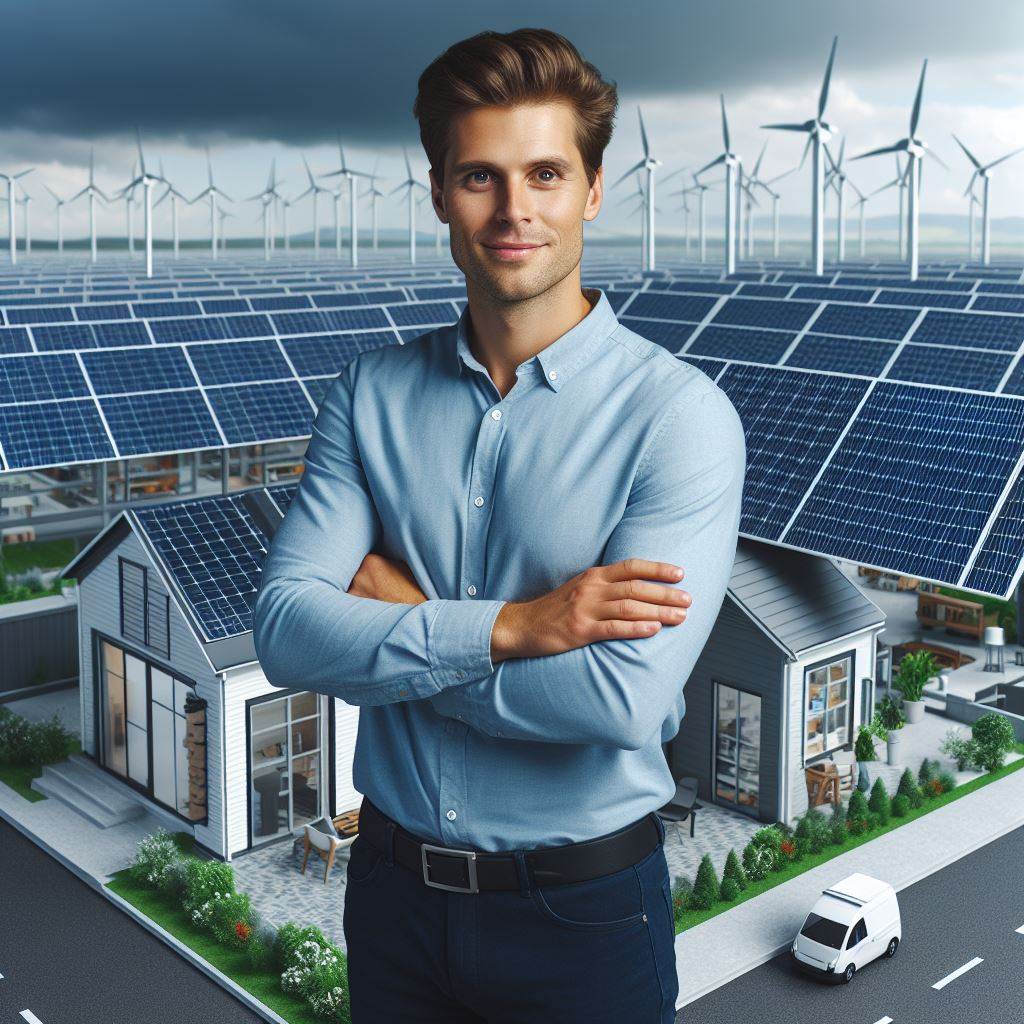Introduction
Energy efficiency is essential in modern buildings due to its numerous benefits.
High energy consumption leads to environmental degradation and increased carbon emissions.
This blog will discuss the importance of energy efficiency, its impact on the environment, and key points to be addressed.
Energy efficiency plays a crucial role in reducing energy consumption and costs.
It helps in improving the overall performance and sustainability of buildings.
By using energy-efficient appliances and systems, buildings can significantly lower their energy usage and carbon footprint.
Excessive energy consumption contributes to greenhouse gas emissions, air pollution, and climate change.
Modern buildings are one of the major energy consumers, and their inefficient use of energy puts a strain on natural resources and contributes to environmental degradation.
This blog post will discuss the importance of adopting energy-efficient practices, such as insulation, efficient lighting, and smart thermostats.
It will emphasize the benefits of energy-efficient buildings, including reduced energy costs, improved indoor air quality, and reduced greenhouse gas emissions.
The post will also provide tips for homeowners and building managers on how to improve energy efficiency in their buildings.
Overall, energy efficiency is key to modern buildings to reduce energy consumption, protect the environment, and save on energy costs.
By adopting energy-efficient practices, we can create a sustainable future and contribute to a greener planet
Benefits of Energy Efficiency in Modern Buildings
Reduction in energy costs
Energy efficiency in modern buildings leads to significant reduction in energy costs.
By implementing energy-saving strategies, such as using energy-efficient appliances and optimizing insulation, building owners can lower their energy consumption and save money in the long run.
Increased comfort and productivity for occupants
Energy-efficient buildings provide greater comfort for occupants.
Proper insulation and efficient HVAC systems ensure a stable and comfortable indoor environment.
This, in turn, improves productivity and enhances the overall well-being of the occupants.
Contribution to a sustainable future
Energy efficiency is a crucial factor in building a sustainable future.
By reducing energy consumption, modern buildings can minimize their carbon footprint and contribute to the global efforts of combating climate change.
Energy-efficient buildings help in preserving natural resources and creating a greener environment for future generations.
Potential government incentives and tax savings
Government bodies often provide incentives and tax savings for energy-efficient buildings.
This serves as a motivation for building owners to invest in energy-saving technologies and practices.
Through these incentives, governments encourage the adoption of energy efficiency measures and accelerate the transition towards sustainable buildings.
Energy efficiency in modern buildings offers numerous benefits.
It not only reduces energy costs but also enhances the comfort and productivity of occupants.
Additionally, it plays a crucial role in creating a sustainable future by minimizing carbon emissions and preserving natural resources.
Besides, building owners can avail potential government incentives and tax savings, further motivating them to prioritize energy efficiency.
Embracing energy-saving strategies in modern buildings is not only financially advantageous but also contributes to a greener and more sustainable world.
Read: Sustainable Design in Retail Properties
Designing Energy Efficient Buildings
As we navigate the challenges of a rapidly evolving world, the importance of energy efficiency in modern buildings cannot be overstated.
Sustainable architecture not only minimizes environmental impact but also contributes to long-term cost savings and a healthier living environment.
In this section, we delve into the crucial aspects of designing energy-efficient buildings.
Incorporating Proper Insulation and Air Sealing Techniques
The foundation of energy efficiency lies in a well-insulated and tightly sealed building envelope.
Proper insulation prevents heat transfer, reducing the need for excessive heating or cooling.
Additionally, air sealing ensures that conditioned air doesn’t escape, maintaining a consistent indoor temperature.
By investing in quality insulation materials and sealing gaps and cracks, buildings can significantly decrease their energy consumption.
Utilizing Energy-Efficient Windows and Doors
Windows and doors are often the weak points in a building’s envelope, allowing heat to escape or enter.
Choosing energy-efficient windows with double or triple glazing and low-emissivity coatings can substantially improve insulation.
Similarly, energy-efficient doors, equipped with weather stripping and proper sealing, contribute to overall thermal comfort.
These measures not only enhance energy efficiency but also create a more comfortable living or working space.
Optimizing Natural Lighting and Ventilation
Harnessing the power of natural resources is a cornerstone of energy-efficient design.
Strategic placement of windows and skylights allows ample natural light to illuminate interiors, reducing the reliance on artificial lighting.
Moreover, optimizing ventilation through thoughtful design ensures a continuous flow of fresh air, promoting a healthier indoor environment and minimizing the need for mechanical ventilation systems.
Using Energy-Efficient Appliances and Equipment
The integration of energy-efficient appliances and equipment is a practical step towards reducing a building’s energy footprint.
From HVAC systems to kitchen appliances, choosing products with high energy efficiency ratings not only conserves resources but also translates to long-term cost savings for the occupants.
In short, the journey toward energy efficiency in modern buildings begins with meticulous design.
By incorporating proper insulation, utilizing energy-efficient windows and doors, optimizing natural lighting and ventilation, and selecting energy-efficient appliances, we pave the way for sustainable and comfortable living spaces that stand the test of time.
Read: Eco-Friendly Offices: A New Real Estate Era
Energy Management and Control Systems: Paving the Way for Sustainable Modern Buildings
In the quest for energy efficiency, the role of Energy Management and Control Systems (EMCS) has become paramount.
These sophisticated systems are the backbone of modern buildings, orchestrating a symphony of energy-saving strategies.
Let’s delve into the key components shaping the future of energy efficiency.
Implementing Smart Thermostats and Automated Controls
Gone are the days of manual temperature adjustments.
Smart thermostats, powered by advanced algorithms, learn occupant preferences and adjust settings accordingly.
Automated controls further optimize lighting, ventilation, and other systems, ensuring that energy is used precisely when and where it is needed.
The result is a harmonious blend of comfort and efficiency.
Monitoring Energy Consumption in Real-Time
Knowledge is power, and in the case of energy management, real-time monitoring is the linchpin.
Cutting-edge sensors and meters provide a granular view of energy consumption.
Building managers can identify inefficiencies promptly, allowing for swift corrective action.
This real-time awareness not only minimizes waste but also facilitates predictive maintenance, extending the lifespan of crucial equipment.
Utilizing Smart Grids and Demand Response Strategies
Smart grids offer a dynamic approach to energy distribution.
They intelligently balance supply and demand, optimizing energy usage across the entire grid.
Coupled with demand response strategies, buildings can adjust their energy consumption based on external factors, such as peak demand periods or fluctuating energy prices.
This not only reduces costs but also contributes to a more resilient and responsive energy infrastructure.
The Benefits of Integrating Renewable Energy Sources
To truly embrace sustainability, modern buildings are increasingly integrating renewable energy sources.
Solar panels, wind turbines, and other clean energy solutions are seamlessly integrated into the energy grid.
Beyond reducing the environmental footprint, this shift towards renewables offers long-term economic benefits, shielding buildings from the volatility of fossil fuel prices.
In essence, Energy Management and Control Systems are the linchpin of energy efficiency in modern buildings.
From smart thermostats to real-time monitoring and the integration of renewable sources, these systems are the catalysts for a sustainable future.
As we navigate the complexities of a rapidly changing energy landscape, embracing these technologies becomes not just a choice but a necessity for creating buildings that are both smart and responsible.
Read: Green Building Trends in Commercial Real Estate

Construction Techniques for Energy Efficiency
Insulated concrete forms (ICFs)
Insulated concrete forms (ICFs) are a popular construction technique for energy-efficient buildings.
These forms consist of two layers of foam insulation that are filled with concrete.
The foam insulation provides excellent thermal resistance, minimizing heat transfer between the interior and exterior of the building.
This results in reduced energy consumption for heating and cooling.
ICFs offer several advantages over traditional building methods.
They provide superior insulation, which helps maintain a consistent indoor temperature and reduces the need for additional heating or cooling systems.
They also offer soundproofing benefits, creating a quieter and more comfortable living or working environment.
Cool roofs and green roofs
Cool roofs and green roofs are two construction techniques that enhance energy efficiency in modern buildings.
Cool roofs are designed to reflect more sunlight and absorb less heat compared to traditional roofs.
They are typically light-colored or have special coatings that reflect sunlight.
By keeping the building’s roof surfaces cooler, cool roofs reduce the need for air conditioning, resulting in energy savings and lower utility bills.
Green roofs, on the other hand, involve planting vegetation on the rooftop.
This technique provides several energy-saving benefits. The vegetation acts as a natural insulator, reducing heat transfer to the building below.
It also improves air quality by purifying pollutants and reduces stormwater runoff by absorbing rainwater.
Green roofs contribute to reducing the urban heat island effect and create a more sustainable and energy-efficient building.
Passive solar design principles
Passive solar design principles aim to maximize the use of natural light and heat from the sun to reduce the need for artificial lighting and heating systems.
This technique involves the strategic placement of windows, overhangs, and shading devices to optimize the amount of sunlight entering the building during winter, while minimizing direct sun exposure during summer.
Passive solar design principles take advantage of the sun’s free energy, reducing the dependency on artificial lighting and heating, resulting in significant energy savings.
Building orientation and site planning
The orientation of a building and careful site planning play a crucial role in optimizing energy efficiency.
By aligning the building’s longest side to face south (in the northern hemisphere) or north (in the southern hemisphere), it is possible to maximize solar gain during winter and minimize solar heat gain during summer.
This reduces the reliance on heating and cooling systems, resulting in energy savings.
Site planning also involves maximizing natural shading from existing trees or strategically planting new trees to block excessive solar heat.
Additionally, incorporating natural ventilation into the design can further reduce the need for artificial cooling systems.
In the end, construction techniques for energy efficiency are crucial in modern buildings to reduce energy consumption and create more sustainable spaces.
Insulated concrete forms (ICFs), cool roofs, green roofs, passive solar design principles, building orientation, and site planning all contribute to energy savings and a greener future.
Read: Sustainable Urban Design: US Trends in 2024
Case Studies and Examples
In the realm of modern architecture, the quest for energy efficiency has become paramount.
In this section, we delve into real-world exemplars that stand as beacons of sustainable design, proving that energy efficiency is not just a theoretical concept but an achievable reality.
Successful Energy-Efficient Buildings
One exemplary case is the Edge, Amsterdam’s greenest office building.
Its ingenious design integrates advanced technologies like smart climate ceilings and solar panels.
The building’s energy consumption is not only 70% lower than traditional structures but also showcases an elegant synergy between form and function.
Moving across continents, Singapore’s Zero-Energy Building (ZEB) at the BCA Academy is a testament to the city-state’s commitment to sustainability.
Harnessing solar power and employing passive design strategies, the ZEB produces as much energy as it consumes, thus earning its zero-energy status.
Real-World Energy Savings and Environmental Impact
The impact of energy-efficient buildings extends beyond reduced utility bills.
Take the Bullitt Center in Seattle, a certified Living Building that generates surplus energy and captures rainwater.
Its net-positive energy performance over the years underscores not only financial savings but also a diminished ecological footprint.
Closer to home, the One Central Park in Sydney showcases the marriage of aesthetics and sustainability.
With its vertical gardens and energy-efficient features, the building has proven that green living can be luxurious.
The energy saved and the emissions reduced make it an exemplary model for urban development.
Lessons Learned and Best Practices
What sets these buildings apart is not just their cutting-edge technology but the wisdom gained in their construction and operation.
From strategic orientation to the use of eco-friendly materials, these projects offer a treasure trove of lessons.
The Edge’s reliance on natural light and smart sensors demonstrates the power of intelligent design, while the Bullitt Center’s emphasis on community engagement showcases the importance of fostering a sustainability mindset.
Basically, these case studies underline that energy efficiency is not a compromise but an elevation of architectural standards.
As we learn from these examples, it becomes evident that sustainable buildings not only contribute to a greener planet but also redefine the very essence of modern living.
The path to a sustainable future is paved with the bricks and mortar of innovation and thoughtful design.
Find Out More: 2024 Trends in Office Space Markets
Financing Energy Efficiency Measures
In the realm of modern architecture, where sustainability is not just a buzzword but a guiding principle, energy efficiency stands tall as a cornerstone.
As we delve into the intricate web of constructing energy-efficient buildings, understanding the financial landscape becomes paramount.
Exploring available financing options for energy-efficient building projects
Embarking on a journey towards energy efficiency requires a robust financial plan.
Thankfully, various financing options exist to support this green evolution.
Government incentives and grants offer a valuable starting point, encouraging builders to adopt eco-friendly practices.
Low-interest loans, often facilitated by environmental agencies, are also a viable option.
Pioneering financiers are stepping up with innovative green bonds and sustainable investment portfolios, aligning profits with planet-friendly projects.
Return on investment (ROI) and payback periods
Skeptics may question the feasibility of investing in energy efficiency, but a closer look reveals compelling returns.
Evaluating Return on Investment (ROI) is imperative to gauge the financial impact of energy-efficient measures.
While the initial costs may seem daunting, the long-term savings in operational expenses, coupled with increased property value, paint a lucrative picture.
Understanding payback periods becomes a crucial aspect – the time it takes for the accumulated savings to offset the initial investment.
Energy-efficient buildings often boast shorter payback periods than anticipated, making them not only environmentally sound but financially astute investments.
Potential challenges and solutions for funding energy efficiency upgrades
While the prospects are promising, challenges persist.
Securing funding for energy efficiency upgrades can be daunting, especially for smaller projects.
Overcoming this hurdle involves creative thinking and collaboration.
Public-private partnerships can offer a shared financial burden, ensuring the integration of energy-efficient technologies without burdening a single entity.
Additionally, raising awareness about the long-term benefits of sustainable construction can attract philanthropic support.
Therefore, the financial landscape of energy-efficient buildings is evolving, providing a plethora of options for those daring to construct a greener future.
As we navigate through available financing options, weigh ROI, and tackle funding challenges head-on, the vision of sustainable, energy-efficient buildings becomes not only a possibility but a financial imperative in the modern architectural landscape.
Conclusion
Throughout this blog post, we have explored the significance of energy efficiency in modern buildings.
We have discussed how optimizing energy usage can lead to reduced costs, improved comfort, and reduced environmental impact.
Energy efficiency is not just an option but a necessity in today’s world.
With the increasing demand for sustainable practices, it is vital to prioritize efficiency in building design and operations.
It not only benefits individuals but also contributes to a healthier planet.
Now that we understand the importance of energy efficiency, it’s time to take action.
Start by evaluating your own energy consumption and make necessary changes.
Explore energy-efficient technologies, such as LED lighting or smart devices, that can make a significant difference.
Additionally, spread awareness about energy efficiency to friends, family, and colleagues.
Advocate for sustainable practices in your community, workplace, and even government policies.
Together, we have the power to create a greener and more efficient future.
By implementing energy-efficient measures, we can reduce our carbon footprint, save valuable resources, and pave the way for a sustainable and energy-conscious society.
Let’s embrace the power of energy efficiency and make a positive impact on our environment and our lives.




